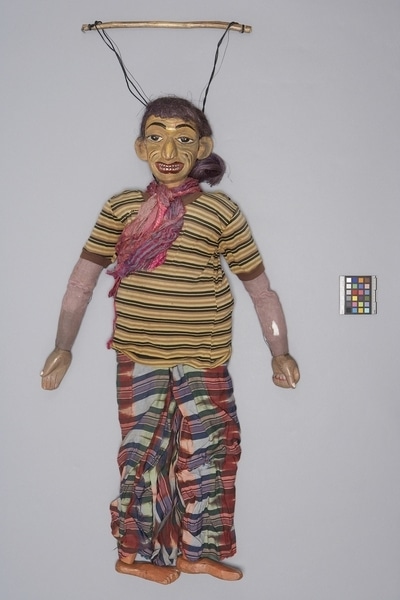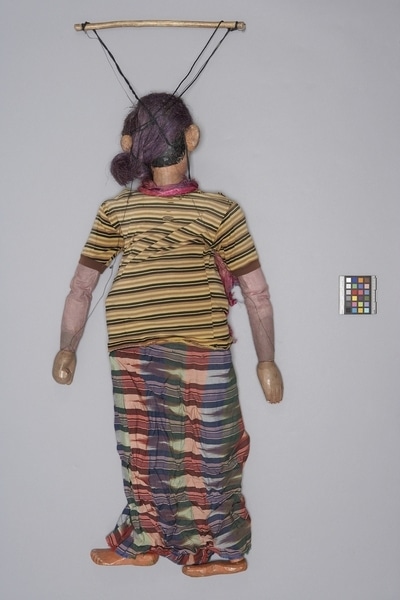String Puppet Item Number: Eh166 a-b from the MOA: University of British Columbia


Description
Three-dimensional male puppet representing the father of a farmer family. Head with purple dyed plant fibre for hair (part b) fits into body clothed in a multicoloured skirt and shirt (part a). The body has jointed arms and legs. The figure is clothed in a yellow, black and brown striped shirt over long pink sleeves and a full-length skirt; a pink and blue scarf is knotted around the neck. Figure's face is a yellow-brown colour with painted black eyebrows, large eyes, protruding ears, an open red mouth with prominent white teeth, and two carved depressions on each cheek. The right hand is closed; the left hand is open. Feet are bare with white toenails. Puppet is attached to thin black cords tied to wooden sticks.
History Of Use
Lifelike in appearance, the striking rukada (string puppets) of Sri Lanka perform stories about ritual practices and everyday life. There is no scripted play, the puppeteers improvise in their storytelling. The characters, in dress, gesture, and action, express social hierarchies and gender roles: the king and the prince; the politician and the village headman; the policeman and the servant boy; and a family of farmers (Farmer, son, wife, daughter). There are also character archetypes such as the sanmi (disease) demon dancer, emaciated beggar with elephantiasis, and jesters in colourful costumes who comically announce the beginning and end of the show (from Shadows, Strings & Other Things, 2019).
Item History
- Made in Galle, Sri Lanka during 1950
- Collected during 1983
- Owned by Jason Schoonover before January 31, 1984
- Received from Museum of Anthropology Shop Volunteers (Funding source) and Jason Schoonover (Seller) on January 31, 1984
What
Who
- Culture
- Sinhalese
- Previous Owner
- Jason Schoonover
- Received from
- Museum of Anthropology Shop Volunteers (Funding source) and Jason Schoonover (Seller)
Where
- Holding Institution
- MOA: University of British Columbia
- Made in
- Galle, Sri Lanka
When
- Creation Date
- during 1950
- Collection Date
- during 1983
- Ownership Date
- before January 31, 1984
- Acquisition Date
- on January 31, 1984
Other
- Condition
- fair
- Accession Number
- 0943/0024